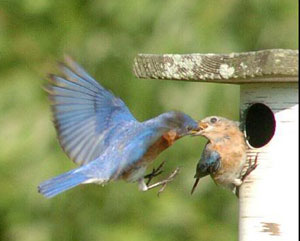Answer: probably maybe sometimes. Bluebirds do form pair-bonds during the breeding season. They are generally “socially monogamous,” meaning that a single male and female form a basic social unit in breeding territory. One study of Eastern Bluebirds (EABL) in Georgia and South Carolina indicated that about 95% of the time, nestings involve one male and one female. (Gowaty 1980.)

Backyard bluebird landlords have noticed that pair bonds can last a long time. Over a 12 year period in California involving Western Bluebirds (WEBL), scientist found that, out of 117 pairs, only 7 changed mates when both mates returned to breed in a second year. In between years, out of 106 re-nests, there were only 3 cases of mate switching (Dickinson et all 1996). 10% (2 out of 20) females that tried to renest in a single year apparently switched mates between broods (JAB and PAG, BNA)
Pairs are considered “bonded” when the females enters a cavity with a male for the first time (Krieg 1971). Eastern Bluebirds (EABL) usually pair up in late fall or winter time. (This is a good indication that the pair may use the box, but is no guarantee.)
There is no data on pair formation for Mountain Bluebirds (MOBLs) before they arrive at breeding grounds. Pairs can remain together between seasons, even when they are in non-breeding season flocks.
During nesting season, the male guards the female to keep her from mating with another male. He is trying to ensure that her progeny are his. However, studies in South Carolina and Ontario with EABLs indicated that 25-30% of broods were sired by more than one male. This appears to be more common when neighborhoods are densely settled (Gowaty 1996 and Gowaty and Bridges 1991b.) It may also be more common with younger males and older females. Promiscuity in other bird species (like Saltmarsh Sparrows) may be because they are at high risk of nesting losses, which might encourage them to seek other or multiple partners in a desperate scramble to reproduce.
In another study of WEBLs in California, 45% of broods had at least one nestling sired by a different male, and about 17% of nestlings were “extra-pair” (involving mating with a different female or male). In a Montana study, 13% of nestlings were extra-apir (Duckworth 2006a.) Another WEBL study in Montana found 13% of nestlings in 27% of nests were extra-pair (Duckworth 2006a) Gowaty found that as many as 20% of EABL(?) nestlings may be fathered by a different parent.
Keep in mind that a bluebird’s life may not be very long. Out in the wild, bluebirds may only live a few years. The oldest known Eastern Bluebird in the wild lived 10 years 6 months. (More info on lifespan.) If a mate is lost, the survivor will seek a new partner, sometimes finding one within hours, depending on availability.
If a nest is unsuccessful, will the pair bond break?
Pairs are more likely to stick together if a previous nesting was successful. One study of EABL showed that 70-85% of successful pairs re-nested with the same partner in the same season, compared to 30-50% of unsuccessful pairs. However, backyard bluebirders have anecdotally reported multiple failed nesting attempts that appear to have involved the same pair, where the eggs were infertile and did not hatch despite repeated attempts.
Can more than one female tend a nest? (Joint Nesting)
Bluebirds may breed cooperatively (jointly)- i.e., more than one female may lay eggs in the same nest, and they both incubate the eggs (either at the same time or one after the other), and cooperate with a male in feeding the babies. This may be because nestboxes or males are limited. Western Bluebirds are more likely to do this – it is rare in Eastern Bluebirds. The joint nesters may be the mother and a daughter from a previous season’s brood.
Social polyandry (one female nesting with more than one male) can also occur.
Bluebirds may also have juveniles from an earlier brood that same season (called hatch-year young) who help feed the babies from a subsequent brood. In WEBLs, helpers may be adult males, adult pairs, or juveniles from earlier broods. (BNA). See more on helping, along with a video.
Egg Dumping
Occasionally (maybe in 1% of nests in EABLs (Gowaty and Bridges), 6% of nests in one study of WEBLS (Dickinson and Akre 1998) a female without a nest (e.g. lost to predation or other catastrophe) may “dump” an egg in the nest of another female.
References and More Information:
- Birds of North American online for studies
- EABL: Guinan, Judith A., Patricia A. Gowaty and Elsie K. Eltzroth. 2008. Western Bluebird (Sialia mexicana), The Birds of North America Online (A. Poole, Ed.). Ithaca: Cornell Lab of Ornithology; Retrieved from the Birds of North America Online: http:// bna.birds.cornell.edu/bna/species/510
- WEBL: Gowaty, Patricia Adair and Jonathan H. Plissner. 1998. Eastern Bluebird (Sialia sialis), The Birds of North America Online (A. Poole, Ed.). Ithaca: Cornell Lab of Ornithology; Retrieved from the Birds of North America Online: http:// bna.birds.cornell.edu/bna/species/381 doi:10.2173/bna.381
- MOBL: Power, Harry W. and Michael P. Lombardo. 1996. Mountain Bluebird (Sialia currucoides), The Birds of North America Online (A. Poole, Ed.). Ithaca: Cornell Lab of Ornithology; Retrieved from the Birds of North America Online: http:// bna.birds.cornell.edu/bna/species/222 doi:10.2173/bna.222
- Longevity records
- Related pages on Sialis.org:
– Emily Dickinson, “Hope” is the thing with feathers, 1891
